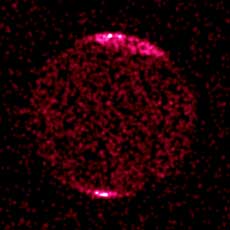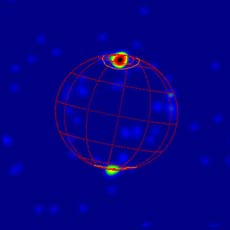
The Chandra X-ray Observatory took this X-ray view of Jupiter. In it, the strong concentration of auroral activity is clear.
Courtesy NASA/CXC/SWRI/G. R. Gladstone
Astronomers have known for more than two decades that Jupiter is a source of X-rays. The phenomenon even had a straightforward explanation: a steady stream of sulfur and oxygen ions, shed by Io, are cascading into the planet's polar regions. There, in much the way magnetospheric electrons hit Earth's poles and cause aurorae, these ions generate X-rays during their collisions with atoms in the Jovian atmosphere.
But observations taken by G. Randy Gladstone (Southwest Research Institute, San Antonio, Texas) have challenged this tidy situation. Using the Chandra X-ray Observatory his team took the most detailed images ever of Jupiter at X-ray wavelengths, and they discovered an auroral "hot spot" that periodically spews out high-energy pulses every 45 minutes.
The origin of this X-ray heartbeat has left theorists scrambling to determine its cause. Because the hot spot has a very high magnetic latitude, the incoming particles must originate from a magnetospheric region at least 30 Jupiter radii (2.1 million kilometers) from the planet. This is far beyond the zone where Io could have supplied the ionic ammunition. Moreover, concurrent measurements taken from the Cassini spacecraft 14 months ago found no correlation between auroral X-rays and solar-wind flux (the other likely source).
While a solar-wind source cannot be ruled out completely, it's unclear how the Jovian magnetosphere could energize the particles in that interplanetary flow to the speeds seen in Chandra's results. If solar-wind ions are really the cause, "Jupiter has got to be involved in the process somehow," says Gladstone. "It's magnetosphere has to excite them."

Chandra observed Jupiter during an entire 10-hour rotation to obtain this movie of the planet's periodic X-ray emission outbursts. Click on image for animation. Warning: The file is quite large (1.5 MB).
Courtesy G. R. Gladstone/NASA.
The periodicity is also difficult to explain. Ions are known to travel from the equatorial regions toward the planet's poles along magnetic fields lines. The period of such ultra-low-frequency oscillations varies for different ions based on their given energy and distance from Jupiter, and theorists are now exploring which ones might provide a match. Still, it's unknown why ions might congregate to yield the observed pulse rate.
"What we need is a good X-ray spectrum of the aurora," says Gladstone. If sulfur is present, he explains, then the source of the ions must be internal to the magnetosphere. The signature of carbon or nitrogen, by contrast, would implicate the solar wind.
 0
0
Comments
You must be logged in to post a comment.